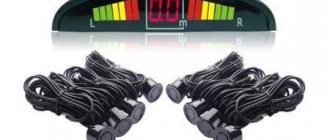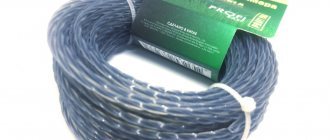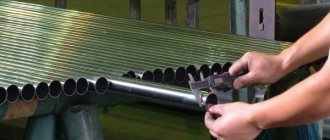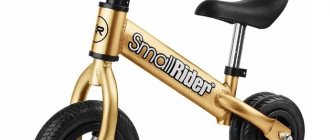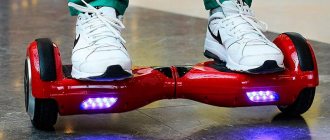Many people love to observe the sky, stars and planets, who can be not only professionals, but also amateurs or children developing their worldview. You can see the details of space using an optical device that you can buy to monitor the sky right from home. For this, a telescope is used, which is divided into several types. The article will help you learn the main types of devices, and will also determine how to choose a telescope for beginners, because there are many parameters and you need to pay attention to everything.
Operating principle and structure of the telescope
Structurally, the telescope is very complex, but with its help you can see the sky at multiple magnification. Visually, the device is made in the form of a tube, where on one side there is a lens for collecting light and/or a lens with a concave mirror. On the other side there is an eyepiece, with the help of which a person looks at the object and gets the desired picture.
To understand the device in more detail, you should consider the main elements in more detail:
- The pipe is the main element.
- The finder is a telescope that is greatly reduced and is necessary for the preliminary search for the desired picture.
- The eyepiece is a part of the device that can be replaced. For example, with a long focus, the magnification will be less, but increases visibility.
- Mount (mount) - often made in the form of a tripod, which includes a pair of rotary axes. Among the main types there are azimuthal and equatorial. The first helps to rotate the pipe in all 4 directions, and the second design is complex and large, but makes it possible to find objects in the sky at given coordinates and take photos.
- Light filters - can be used for many purposes, including dimming very bright light from the moon.
- Diagonal mirrors are an important detail that helps turn the picture upside down, since the image in the device itself is “upside down”.
Professional devices can take photos and videos, and are often supplemented with electronic equipment, a GPS module, and an electric motor.
Types of telescopes
To figure out how to choose a telescope for observing planets, you will need to study the main types. They determine the capabilities and scope of use.
Reflectors (mirror)
This model allows you to capture the light flux and transmit it to a person using a pair of concave mirrors. One of them is located in the telescope lens, and the second allows you to reflect the image at an angle and send it to the side eyepiece.
This optics is considered well suited for analysis and observation of deep space, and also helps to obtain clear and high-quality images of distant objects in the sky. The average cost when using an equatorial stand will be in the range of 14-55 thousand rubles. It is believed that this technique is not recommended for beginners and children, since it is very difficult to set up and operate the device.
Pros:
- A simple and understandable design for many.
- Small size and weight.
- Easily copes with objects that emit low light and are far away.
- A good aperture of 250-400 mm, which helps to see a bright and clear image without defects.
- Optimal cost when compared with similar refractors.
Minuses:
- Setting up the device will require a lot of time, and you also need experience working with the device.
- Since the structure is open, dust, dirt and water can penetrate into it.
- High sensitivity to temperature changes.
- The technology is not suitable for tracking terrestrial objects, as well as nearby bodies in our solar system.
Refractors (lens)
This type of telescope can be identified by its simple design, which is visually similar to a regular telescope. The eyepiece and lens are placed on the same axis, and the magnified image is transmitted in a straight line, similar to models that were in use hundreds of years ago.
Refractors are refracting optical devices that collect reflected light from objects in the sky using a lens. This element can be 2-5 biconvex and is installed on both sides of the pipe. This type of equipment is more suitable for beginners and amateurs, as it will help to see in detail ground objects, objects in the sky that are located in our solar system.
The lenses work in such a way that there is a partial loss of image clarity, so the image will be dimmer while viewing and working, especially if you use the maximum magnification. It is recommended to use such optics for open areas outside the city in order to completely prevent the sky from being illuminated.
Based on the type of lenses in the telescope, instruments can be divided into achromatic and apochromatic. The first options have a flat picture, but they have a low and medium magnification level. The second models will make the image convex, but allow you to remove defects, including unclear image boundaries and the formation of a secondary spectrum.
The average cost of a refractor using an azimuth mount will be in the range of 3,500-25,000 rubles. The price directly depends on the technical features, as well as the functionality of the equipment.
Pros:
- Easy to use due to the lack of special maintenance.
- The design is sealed, therefore it is reliably protected from penetration of moisture or dust into the housing.
- Not negatively affected by temperature fluctuations.
- Provides high clarity and contrast images of nearby bodies in the sky.
- Characterized by a long service life.
Minuses:
- Large dimensions and weight of the entire structure, in some cases it can reach up to 25 kg.
- The maximum lens diameter is 150 mm.
- The models are not suitable for viewing the sky within the city.
Catadioptrics (mirror lens)
The lens of such equipment is made on the basis of lenses and mirrors, due to which all the positive aspects of the models described above are collected in the device. In addition, the telescope makes it possible to eliminate defects as much as possible using specialized correction plates.
During human observation, video provides an almost perfect image of any objects in the sky, regardless of their distance. The telescope can be considered professional, in addition to this view, it is possible to take good photos. The cost of models with the ability to create photos starts from 10,000 rubles and ends at 3 million rubles. Professional catadioptric installations with optimal power will range from 18-95 thousand rubles.
Pros:
- Small sizes for easy transportation.
- Great for tracking bodies in space at any distance.
- This type allows you to get maximum picture quality.
- Large aperture, up to 400 mm.
Minuses:
- Structurally complex models.
- High pricing policy.
- Long period of thermal stabilization of air in the middle of the device.
Universal designs for beginners
Veber 400/80 AZ
Our rating opens with a design characterized by its compactness, excellent aperture ratio and reasonable cost. The telescope is perfect for long trips into nature, but it can be installed at home or in an apartment. The eyepiece is equipped with a Schmidt prism, the image is straight, not mirrored. The maximum magnification is 160 times - through such a telescope you can see lunar craters with a diameter of about 7-8 km, see the rings of Saturn, the clouds of Jupiter, and so on. The lens here is achromatic, due to which the picture is as clear and sharp as possible across the entire field of view - there is no distortion or coloration at the edges.
Particular attention should be paid to the ocular part. It is located at an angle of 45 degrees to the axis of the device, and, if necessary, can rotate, locking in one of eight positions. Thanks to this opportunity, observation becomes more comfortable - you can look at the starry sky both in a standing and in a sitting position. The picture is straight, not mirrored. The design provides an azimuth mount, which even a child can handle, there are two micrometric handles responsible for pointing, and a viewfinder is also installed. Thanks to all these elements, the telescope can be accurately aimed at the target. A tripod is not included in the kit; it will have to be purchased separately.
More: Tronsmart releases headphones with a Qualcomm chip and UV sterilization - Tronsmart Onyx Free
Advantages:
- The parameters are balanced just perfectly;
- One of the lightest in our entire review - its weight is only 4 kg;
- Reasonable price.
Flaws:
- The mount should be handled with the utmost care - there is a high probability of damaging it.
Veber 400/80 AZ
2. Levenhuk Strike 80 NG
A refracting telescope is lightweight and can be carried in one hand if necessary. When disassembled, the dimensions are small - about 80 cm, so you can even travel with such a telescope on public transport. The design includes a wrapping prism, due to which the picture is not inverted, but straight. The telescope is considered universal, since it can also be used to observe earthly objects; it is used even during daylight hours. The pipe of the device is painted white and practically does not heat up in direct sunlight. The build quality of the device is excellent. The design is very neat and reliable.
The viewfinder has a red dot called Starpointer, which makes it even more convenient to use; finding the desired object in the sky is quite simple. Before you begin observations, it is worth aligning the viewfinder coaxially with the main tube of the product. The focuser is made of high-quality plastic with increased rigidity, is characterized by a soft stroke, and there is no play. The telescope has an alt-azimuth Yoke mount, which makes the product lighter and easier to control. There is a special lens hood that is designed to provide high-quality protection of the lens even from strong impacts and dew. It installs on the tripod very quickly. A special planetarium program is supplied with the telescope, there is also a book for beginner astronomers and a compass. All these points allow you to quickly master the basic skills of using a telescope for its intended purpose.
Advantages:
- The highest useful magnification is 360x;
- The viewfinder is equipped with a red dot;
- The kit contains everything you need for comfortable work with this equipment.
Flaws:
- The aperture ratio is rather weak, so it is recommended to use the telescope exclusively for observing dim celestial bodies.
Levenhuk Strike 80 NG
1. Celestron AstroMaster 130 EQ
This is a very functional product, which is characterized by excellent quality of both assembly and the resulting image. The optics here are powerful, all mechanical elements are reliable, and using this telescope is very easy. Through it you can view a lot of space objects, and the picture will be bright and contrasting. The design is modern and interesting. Such a telescope will be most suitable for a person who is seriously interested in astronomy. Using this equipment, you can view many stars in our galaxy, various constellations - Sagittarius, Aquila, Scorpio, Cassiopeia and many others. It is quite natural that through a telescope it will be possible to see all the main planets of our solar system, various nebulae, and so on.
The kit comes with a viewfinder with a red dot, in addition, there are two eyepieces, the diameters of which are 10 and 20 mm. The first allows you to get a picture enlarged by 33 times, the second – by 65 times. With such eyepieces you can quickly catch the desired object. 2x and 5x Barlow lenses provide high power to the telescope, and there are also special filters for the moon and stars. At maximum settings, you can get a magnification of 307x - in this case, you will be able to see craters, paths, famous Martian canals, and so on.
Advantages:
- Reasonable cost;
- High image quality;
- Sturdy and reliable assembly;
- Insignificant mass.
Flaws:
- At first, catching a celestial body through the lens will be quite problematic.
Celestron AstroMaster 130 EQ
Telescope for a child
For children, a telescope is not only an unusual and interesting gift, but also very useful. When choosing, experts recommend using the following recommendations:
- Children can only handle very basic telescope controls from about 8 years of age.
- For schoolchildren who are just beginning to study the sky and the world in general, it will be enough to buy a regular refractor. Its cost is optimal, the optical device is easy to care for, and its reliability is very high.
- To view the moon and nearby objects in the sky, it is enough to select an aperture of 70 mm.
- The best telescope mount for a child is azimuth. It turns out to be cheaper, easier to learn, and you can observe not only celestial bodies, but also ground-based objects.
Almost all manufacturers of optical instruments in their range can offer models of telescopes for children, which are characterized by high durability. In addition, parents are recommended to immediately buy a star map, as well as a manual for young astronomers. The average cost for simple children's models starts from 1000 rubles, but more functional and advanced devices need to be paid up to 25 thousand rubles.
The best telescope manufacturers
In specialized stores you can find a large selection of telescopes, at different prices and parameters. Although this product is not the most popular, the range is sufficient and there are many manufacturers who offer equipment.
Large companies can provide high-quality optical instruments for people of different levels. There are full-fledged models for beginners, as well as inexpensive devices for children or schoolchildren. The most functional devices that are considered professional deserve special attention. To enjoy your purchase and become the owner of high-quality optics for observing the sky, it is recommended to pay attention to the following companies:
- Sky-Watcher;
- Celestron;
- Bresser;
When choosing, you should focus not only on the brand name, but also on a number of important parameters that characterize the product. You should also determine your own requirements for the telescope, and the tips will help you choose the best option.
How to choose the right telescope for an amateur - basic parameters
If you decide to buy a telescope, you will need to highlight the main requirements for it. To do this, understand what will be viewed in the sky, where the observation is planned from (from the balcony or in the field), and whether future activities will be related to astrophography. After answering these questions, you can move on to considering important parameters.
Aperture
This indicator is the diameter of the lens and is considered the main indicator for a telescope. The aperture allows the lens or mirror to collect light and the higher the value, the more light enters, which allows you to improve the quality of the picture and catch even the faint glow of distant bodies in the sky.
When choosing a telescope by aperture for personal needs, you should focus on the following indicators:
- For maximum clarity of nearby planets, stars, and satellites, you should choose a device with a lens size of up to 150 mm. For urban conditions, it is better to reduce the value within 70-90 mm.
- If you need to look further into the sky, then a diameter of more than 200 mm is used.
- In cases where the telescope is used frequently and observation is a hobby, and the whole process is carried out outside of urban conditions, then it is best to buy semi-professional lenses with an index of up to 400 mm.
Magnification ratio
The value can be determined by dividing the focal length by a similar parameter of the eyepiece. For example, the F of the telescope is 800 mm, and the eyepiece is 16, in which case the telescope gives 50x.
Users can adjust magnification by changing eyepieces themselves, using more powerful or weaker models. At the moment, manufacturers offer options in the range of 4-40 mm, to double the focus of the device, Barlow lenses are used.
When choosing the magnification, you need to understand that detailed examination is important for close objects, for example, when viewing the Moon, and distant bodies do not require careful selection of the magnification.
Focal length
This value indicates the distance from the lens to the point in the eyepiece when all the light is collected into a beam. This characteristic determines the picture quality and magnification level. The higher the indicator, the better visible bodies in the sky.
Focus allows you to increase the length of the telescope, which has a positive effect on transportation and storage. If observation is carried out from a balcony, then it is more convenient to use models with a short focus within 500-800 mm. This ban does not apply only to catadioptrics, because in them the light is refracted many times and does not go in a straight line, so manufacturers can significantly reduce the body.
Mount type
A stand for an optical device will be required for more convenient and comfortable use. Telescopes are often equipped with a mount, which can be of 3 types:
- Azimuthal - a simple stand model that allows you to move the device in different directions. Often the device is provided with refractors and simple catadioptrics. This type is not suitable for models capable of taking videos and photos, since it is impossible to capture a clear image with it.
- Equatorial - characterized by large size and mass, but allows you to find the desired bodies by coordinates. An ideal option for reflectors that work with remote space objects. The mount is popular among people who take photos and videos of the galaxy.
- The Dobson system is a middle option between the stands already presented. As a rule, manufacturers offer it for powerful and expensive reflectors.
Best Hybrid Telescopes
3. Levenhuk Skyline PRO 80 MAK
This model is considered by many astronomers to be professional; it is produced on the basis of the Maksutov-Cassegrain system of lenses and mirrors. The telescope is quite compact in size, and the picture is of very high quality. First of all, such a telescope is designed for observing distant space objects - double stars, clusters, nebulae and galaxies. The lens diameter is 80 mm. The telescope is mounted on a reliable German-made equatorial mount. The tool is well suited for outdoor trips, especially since it does not weigh too much. The lenses are coated with anti-reflective compounds, allowing maximum light to pass through them. Mirror surfaces also have a special protective layer, which significantly increases their service life.
More: Top 10 best drills for winter fishing: how to choose the right ice drill
The equatorial mount is equipped with fine movement handles and has a connector for installing an electric motor. The mount has special coordinate circles, due to which you can quickly find the required object using celestial coordinates. The tripod is height adjustable and has a shelf. With the help of such a telescope, you can get the highest return, which will be very useful both for observations and for taking photographs of various space objects.
Advantages:
- Good aperture;
- Small size and weight;
- If necessary, you can connect various kinds of accessories.
Flaws:
- Expensive design.
Levenhuk Skyline PRO 80 MAK
2.CELESTRON NEXSTAR 4 SE
In second place in this section of the ranking of the best telescopes is a universal device with an attractive optical design. It is easy to install and has a compact size, and the cost is quite reasonable. The diameter of the main mirror is 102 mm. With such dimensions, it will be possible to discern relatively close objects located mainly within the Solar System. The optics are treated with anti-reflective compounds and are produced using Star Bright XLT technology, which minimizes possible light loss. The telescope comes complete with a database that includes over 4,000 cataloged objects. If necessary, it can be updated via the Internet.
The telescope is fully computerized and has a motorized fork mount - this allows you to find and monitor space objects automatically. SkyAlign guidance system - just point it at three stars, after which it will align the device. This function is very convenient for beginners. The telescope operates on the basis of the Maksutov-Cassergrain optical design; it will not require additional color calibration. The dimensions of the optical tube are small and it is also characterized by its low weight. The tripod is very easy to fold.
Advantages:
- Can be brought into working position in just a few minutes;
- Portable dimensions;
- Light weight;
- Does not require calibration.
Flaws:
- Due to the diameter of the main mirror, it is not always possible to view objects located in deep space.
CELESTRON NEXSTAR 4 SE
1. Levenhuk SkyMatic 105 GT MAK
The undisputed leader in its segment of the best telescopes is this design, which has a pointing function. Another important advantage in terms of equipment operation is the relatively low weight and compact overall dimensions. This was achieved largely thanks to the use of the Maksutov-Cassegrain optical scheme. The diameter of the main mirror is 102 mm, the focal length is significant - this allows you to view both fairly distant objects such as nebulae or star clusters, and close ones - planets, comets, asteroids, satellites, and so on. The mount is equipped with drives on each axis, making it possible to take photographs with short shutter speeds. Using a standard DSLR or even a webcam, you can get an excellent broadcast from the lunar surface. The telescope finds all the required objects on its own.
The alt-azimuth mount with automatic guidance function is very simple to operate - even a child can figure it out. Guidance is carried out using a special remote control with a SynScan AZ system. The database contains over 40,000 space objects. If necessary, the telescope is connected to a laptop or personal computer - there is a special cable for this, and control is carried out using a number of programs. The telescope comes with two eyepieces with focal lengths of 10 and 25 mm.
Advantages:
- Can be controlled using a computer;
- There is a function of automatic targeting of objects;
- If necessary, you can connect various kinds of accessories;
- The tripod is very convenient and weighs a little.
Flaws:
- It costs expensive.
SUN AND MOON in Levenhuk Skyline PRO 105 MAK
Levenhuk SkyMatic 105 GT MAK
Which telescope to choose
Experts advise using their recommendations when choosing if it is difficult to decide on a telescope on your own:
- Beginners who are located within the city should use refractors with a short focal length and a lens diameter of 70-90 mm. If you have the opportunity and plans to travel outside the city for observation, then it is advisable to buy a 110-250 mm reflector with a Dobsonian stand.
- For those who study the galaxy and the sky, you need to use reflectors with an aperture of 250 mm or more, as well as an azimuth mount.
- Travelers and people who are constantly on the move will need a lightweight but reliable mirror-lens type device with an azimuthal or Dobsonian mount.
- For experienced people who prefer to take photos, you will need a catadioptric device with an aperture of 400 mm and a focus of 1000 mm. The stand in this case will be of an equatorial type with an automatic drive.
- Children are recommended to buy simple and affordable refractor models, with an aperture of 70 mm and above and an azimuth stand.
[Total: 50 Average: 5/5]
Best Telescopes for Beginners
Such devices have basic configuration and a standard set of functions. They are easy to operate, provide a high-quality picture and, if desired, can be supplemented with various accessories.
Celestron Travel Scope 80
4.9
★★★★★
editorial assessment
89%
buyers recommend this product
The aperture of this telescope is 80 mm, the focal length is short - 400 mm. The portable refractor, including all packaging, weighs 2.9 kg, which allows you to take it with you on hikes and night walks. The set includes a highly durable nylon backpack.
Two eyepieces provide magnification of 20x and 40x. The inverting prism correctly aligns the image, and fully coated optics make it contrasty and natural.
The classic, smooth-running alt-azimuth mount allows you to easily point the telescope at objects using the handle.
Advantages:
- Smartphone adapter for mounting on the eyepiece;
- Compact size and light weight;
- A program with data on 10,000 space objects;
- Possibility of printing star maps;
- Full multilayer coating of optics;
- Maximum magnification – 160x.
Flaws:
- Flimsy tripod.
This is an excellent model for tourists and travelers - light and comfortable. And it has more than enough functionality for beginners.
Sturman 60700 AZ
4.8
★★★★★
editorial assessment
88%
buyers recommend this product
This is a refractor with an aperture of 60 mm and a focal length of 700 mm. With its help, the user receives a detailed image without distortion. The device is also suitable for ground-based observations. The maximum useful magnification is 120x.
Advantages:
- Coated optics;
- Alt-azimuth mount with simple controls;
- Three eyepieces and a 3x Barlow lens included;
- Residual chromatism is 1.5 times less than that of a conventional refractor;
- Long focal length lens.
Flaws:
- Afraid of shocks and moisture.
Sturman 60700 AZ allows you to observe planets, satellites, lunar craters and other objects. Double stars are clearly visible through it.
Veber PolarStar 900/90 AZ
4.7
★★★★★
editorial assessment
87%
buyers recommend this product
See review▶
The telescope's marking indicates that its lens diameter is 90 mm and its focal length is 900. The minimum magnification is 45x, the maximum is 300x.
This model has coated optics and an alt-azimuth mount. The telescope gives a non-inverted image, since the diagonal prism is already built into the design.
Advantages:
- Reliable metal mount without plastic parts;
- Bag for storage and carrying;
- Rich equipment;
- Optical finder 6x;
- Adjustable tripod height 80-125 mm.
Flaws:
- At maximum magnification, distortion appears.
This device will allow you to observe the Moon, nearby planets and deep space objects.
Bresser National Geographic 114/500
4.6
★★★★★
editorial assessment
86%
buyers recommend this product
See review▶
Bresser is a so-called Newtonian reflector with a primary mirror diameter of 114 mm and a focal length of 500 m.
It comes with 6 and 20 mm eyepieces, as well as a 2x Barlow lens and a lunar filter that reduces the brightness of the moon.
The maximum useful magnification is 167x, the minimum is 25x. The telescope is controlled manually. The red dot finder quickly aims the optics at the desired object. And the easy-to-install mount is equipped with a compass.
Advantages:
- Compactness;
- Matte blackening of the inner surface of the pipe;
- Smooth operation of the focus control;
- Includes a star map and a disk with a computer planetarium;
- Stable Dobson mount.
Flaws:
- Not coated optics;
- Small eye lenses.
With this model you can study double stars, nebulae and other space objects. Purchasing additional eyepieces will allow you to make high-quality observations.
Sky-Watcher BK P130DS OTAW Dual Speed Focuser
4.5
★★★★★
editorial assessment
85%
buyers recommend this product
The aperture of this device is 130mm and the focal length is 650mm. The main mirror has the shape of a parabola. Maximum magnification – 260x.
The image is clear, without spherical distortion and chromatism. The Focuser performs well when photographing and observing at maximum magnification.
Advantages:
- Two-speed Crayford focuser with smooth operation;
- Coating of optics with silicon dioxide;
- Thin secondary mirror (0.5 mm);
- Optical finder 6x30;
- Additional eyepiece 28 mm with 23x magnification.
Flaws:
- You will have to purchase the mount and tripod yourself.
The optical capabilities of this reflector allow you to study deep space objects and engage in astrophotography.
READ ALSO
8 best scopes

